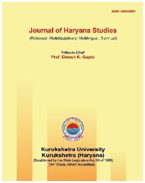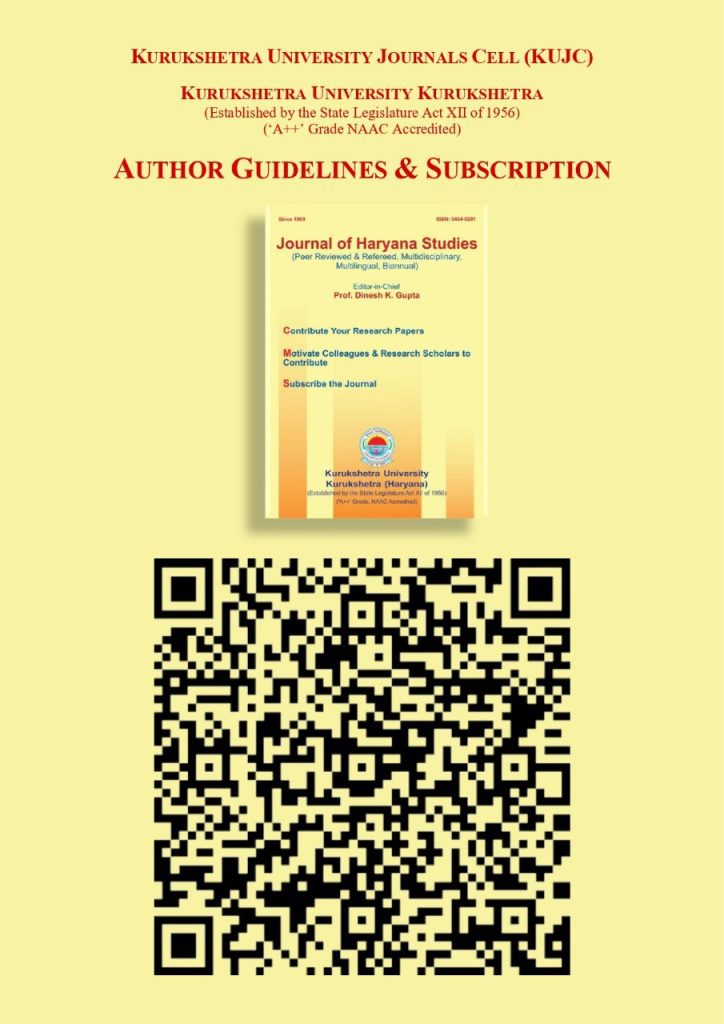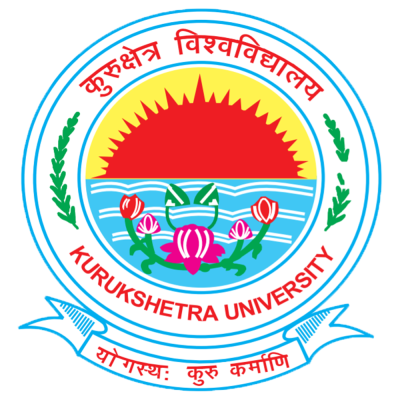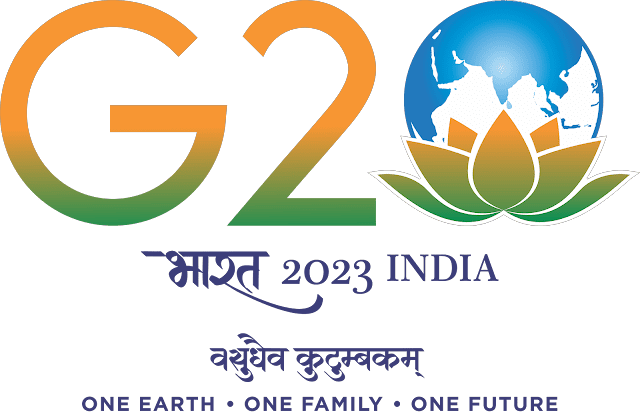Important Links >> KUJC >> Journal of Haryana Studies
Journal of Haryana Studies

About
Journal of Haryana Studies (JHS) is sponsored, edited and published since 1965 (Annually) by Kurukshetra University.
JHS is Peer Reviewed, Multidisciplinary, Multilingual (English, Hindi, Sanskrit & Punjabi), Biannual (w.e.f.2021) Journal.
It is open for original studies about Haryana’s history, culture, language, literature etc., research, evaluative, analytical and technical studies on all subjects related to Haryana both theoretical and empirical in nature.
All submitted research papers are subject to double blinded review.
The Journal of Haryana Studies has its own utility and significance as it provides an excellent forum for dissemination of information pertaining to Haryana for last more than five decades.

Patron
Guidelines for Contributors
Submission of Papers
Authors should submit the computer print in duplicate, typed on both sides of A4 size paper, with a margin not less than 1” on the left side. Each copy should include: (i) Title Page (ii) Abstract, (iii) Nomenclature of SymbolsUsed, (iv) Table/ Figure/ Illustrations typed/ drawn along with their captions (mandatory) in serial order as they appear in text, and (v) a separate List of Table/ Figure captions. Tables/ Figures/ Illustrations are published only in black and white, and must therefore retain their clarity in a greyscale presentation.
Typescript specifications
| Sr. No. | Language/Script | Software/ Font | Font Size | Line Spacing |
| 1 | English | MS WORD, Times New Roman | 12 | 1.3 |
| 2 | Hindi | Mangal | 12 | 1.3 |
| 3 | Punjabi | Ravi | 12 | 1.3 |
| *Use Unicode for maintaining uniformity | ||||
Headings for Sections and Sub-sections
- Title of Paper should be 16 points in Bold Title case.
- Main section heading should be 14 points in Bold Title Case
- The subheadings should be 12 points in Bold Title Case.
- The sub-subheadings should be 12 points in Bold Italic Title Case.
The Title of the paper shouldbe concise and informative of the contents of the paper.
The Authors need to submit 2 copies of papers:
- One copy should include – Title of the Paper, Name(s) of the Author(s), Designation and Affiliation(s), and E-Mail and the Name and E-mail Address of the Corresponding Author(in case of multi-authored papers), ORCID Id. on one page, followed by text of the paper.
- The second copy should contain Title and text of the Paper only and no Author details and identification.
Names of Author(s), Designation and his/their identification symbols such as Address, Email, Institutional Affiliation, etc. should not be mentioned anywhere in the manu script.
The second page should carry the Title of the Paper again; followed by an Abstract and 4 – 5 Keywords that describe the content of the paper. Acronyms and abbreviations should be spelt out in full when first used in text.The manu s c r i p t should preferably (not necessarily) be of around 3000 – 4000 words.
The authors should submit papers online though the University Website https://kuk.ac.in/
Abstract
The informative abstract of about 150 – 200 words conveying the scope of the paper, emphasizing the results and conclusions must be included. The abstract must be intelligible on its own; without reference to the main text. Abstract should not include anything that is not covered in the paper.
Review Process
All manu scripts will be subject to blind peer review. Based on the reviewers’ recommendations, the editor then decides whether the paper should be accepted as is, revised or rejected.
The manu script will be subject to plagiarism checking for the originality of submissions received.
Referencing Style
The completeness and accuracy of bibliographical details of citations should be ensured.For references Publication Manual of American Psychological Association (APA), 7th Edition (2020) should be followed and carefully checked for completeness, accuracy and consistency. This is very important in an electronic environment because it enables your readers to exploit the Reference Linking facility on the database and link back to the works you have cited through CrossRef.The in-text Citation Style should be Author-Date Style: (Joshi, 2019). The list of documents in references part should be arranged in alphabetical order of First Author’s Surname/ entry word. Samples of some frequently used type of documents are given below (examples are based on the pattern recommended by APA Style Blog):
-
Journal Article
Reference part –Jha, A. (2021). America needs a global health policy for the pandemic age. Foreign Affairs, 100 (2), 103-115.
In-text citation – Parenthetical citation – (Jha, 2021)
Narrative citation – Jha (2021)
In-text citation will be in the same style while citing all type of documents. -
Book
Krishnan, A. (2020). India’s China challenge: A journey through China’s rise and what it means for India. HarperCollins.
-
Edited Books
Bartram, B (Ed.). (2018). International and comparative education: Contemporary issues and debates. Routledge.
-
Chapter in an Edited Book
Park, Z. & Kim, H. (2013). Organizing and sharing information using linked data. In J. Park, & L.C. Howarth (Eds.), New directions in information organization (pp. 61-87). Emerald Group Publishing.
In-text Citation – Parenthetical Citation – (Park & Kim, 2013)
Narrative Citation – Park and Kim (2021)
-
Paper in Conference Proceeding
Gupta, S., & Singh, S.P. (2006). Future competencies for LIS professionals in 21st century. In N. Laxman Rao, & S. Sudarshan Rao (Eds.), Quality education in Library and Information Science. Seminar papers and proceedings XXII IATLIS National Conference (pp. 121-128). IATLIS.
-
Unpublished Dissertation or Thesis
Gupta, S., & Singh, S.P. (2006). Future competencies for LIS professionals in 21st century. In N. Laxman Rao, & S. Sudarshan Rao (Eds.), Quality education in Library and Information Science. Seminar papers and proceedings XXII IATLIS National Conference (pp. 121-128). IATLIS.
-
Website References
Website’s name (with URL in parentheses) is given in the text; no reference to be given.
In-text citation as narrative citation-
INFLIBNET Centre (https://inflibnet.ac.in/) -
Webpage in a Website
In a government or institutional website, if no specific author is mentioned for webpage, the government agency or institution responsible for the site is treated as author.
National Informatics Centre. (2021). Emerging technology. India, Ministry of Electronics and IT, National Informatics Centre. https://www.nic.in/emerging-technology/
Note
- For documents available over Internet, if DOI is given, it will be given after the last bibliographic field of the entry. In the absence of DOI, URL shall be given.
- The First/Corresponding Author shall submit along with manu s c r i p t, an originality certificate signed by all the authors (either in one or separately) on the prescribed format availablein Journal; stating that the manu s c ri p t has neither been published nor submitted for publication in any other journal/ document.
- Every Authorshall be entitled for a softcopy of his/ her contribution.
- Copyright of the papers published shall vest with Journal of Haryana Studies. Authors will be allowed to submit the papers to their institutional repository and/or Author’s personal website; for other submissions prior written permission of the Editor-in-Chief, JHS will be mandatory.
- Authors, who wish to get their books reviewed in JHS, should send two copies of the book to the Editor.
Subscription & Tariff
| Duration | LIndividual | Institutional | Postal Handling Charges | Total |
| 1 Year | English | MS WORD, Times New Roman | 12 | 1.3 |
| 2 Year | Hindi | Mangal | 12 | 1.3 |
| 3 Year | Punjabi | Ravi | 12 | 1.3 |
| *Use Unicode for maintaining uniformity | ||||


